AS ANOTHER DIRECTOR EXITS 'STAR WARS', DE PALMA A TOP CHOICE FOR SOME...

Updated: Tuesday, September 5, 2017 7:15 PM CDT
Post Comment | View Comments (2) | Permalink | Share This Post
 Hello and welcome to the unofficial Brian De Palma website. Here is the latest news: |
|---|
E-mail
Geoffsongs@aol.com
-------------
Recent Headlines
a la Mod:
Listen to
Donaggio's full score
for Domino online
De Palma/Lehman
rapport at work
in Snakes
De Palma/Lehman
next novel is Terry
De Palma developing
Catch And Kill,
"a horror movie
based on real things
that have happened
in the news"
Supercut video
of De Palma's films
edited by Carl Rodrigue
Washington Post
review of Keesey book
-------------
Exclusive Passion
Interviews:
Brian De Palma
Karoline Herfurth
Leila Rozario
------------
------------
| « | September 2017 | » | ||||
| S | M | T | W | T | F | S |
| 1 | 2 | |||||
| 3 | 4 | 5 | 6 | 7 | 8 | 9 |
| 10 | 11 | 12 | 13 | 14 | 15 | 16 |
| 17 | 18 | 19 | 20 | 21 | 22 | 23 |
| 24 | 25 | 26 | 27 | 28 | 29 | 30 |
De Palma interviewed
in Paris 2002
De Palma discusses
The Black Dahlia 2006

Enthusiasms...
Alfred Hitchcock
The Master Of Suspense
Sergio Leone
and the Infield
Fly Rule
The Filmmaker Who
Came In From The Cold
Jim Emerson on
Greetings & Hi, Mom!
Scarface: Make Way
For The Bad Guy
Deborah Shelton
Official Web Site
Welcome to the
Offices of Death Records

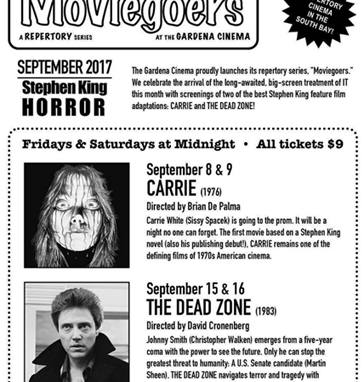 With a new adaptation of Stephen King's It opening this Friday, there have been many articles of late discussing the many adaptations of King's works. A couple of days ago, Scott Tobias posted an article at the Washington Post with the headline, "The secrets to making great Stephen King movies"...
With a new adaptation of Stephen King's It opening this Friday, there have been many articles of late discussing the many adaptations of King's works. A couple of days ago, Scott Tobias posted an article at the Washington Post with the headline, "The secrets to making great Stephen King movies"...Some have stuck to the page, letter by letter, and others have only a casual relationship to the text — neither approach is a guaranteed winner.But there are some connections to be made among the strongest King adaptations. The first is counterintuitive: King characters are best understood from the inside out. That goes against conventional wisdom, because the most adaptable books tend to be short on interior monologue and long on external action, which is why a sledgehammer narrative such as James M. Cain’s “The Postman Always Rings Twice” has been adapted multiple times in English, in Italian (“Obsessione”), in German (“Jerichow”) and in Chinese (“Ju Dou”), and the novel’s murderous love triangle has been resonant every single time. Finding some visual analog for a character’s thoughts is a trickier proposition.
Yet the true horror of films such as “Carrie,” “The Shining,” “The Dead Zone” and “Christine” has to do with transformation, of ordinary stresses escalating into supernatural possession. In Brian De Palma’s hands, “Carrie” turns a teenage girl’s coming of age into a tale of profound isolation and sexual repression, with her desire for womanhood thwarted by her cackling peers on one side and the shame of her fanatically religious mother on the other. Even when her extrasensory powers torch the high school and beyond on prom night, it’s as heartbreaking as it is horrific, a manifestation of pain she can no longer manage.
In Stanley Kubrick’s “The Shining” and John Carpenter’s “Christine,” there’s a chicken-and-the-egg quality to the relationship between the lead character and the sinister object of their obsession. Perhaps the Overlook Hotel or that snarling 1958 Plymouth Fury would wreak havoc without them, but human weakness and temptation are animating forces in both films, to the point where a symbiosis develops between those forces. We might fear the goings-on in Room 237 or the animal roar of a sentient muscle car, but the source of each fear is so deeply connected to one man’s ravaged psyche, we can’t get a distance from it. David Cronenberg’s “The Dead Zone” makes a curse out of a gift, martyring a man who can see the future at the price of his life.
The other common thread is filmmakers who refuse to act as stenographers and invent or embellish beyond the page. Despite all the misbegotten adaptations of his works, King is most famous for detesting what Kubrick did with “The Shining,” a film many would rank among the scariest of all time. But at the center of that animus is King’s perception of creative disrespect: He wrote a deeply personal horror novel about alcoholism and authorship, only to have Kubrick strip it for parts with the ruthlessness of a chop-shop mechanic. Yet it was Kubrick’s prerogative as an artist to reimagine the novel and make the film a separate entity.
Although other filmmakers haven’t been as dismissive of the source material, they’ve benefited from their own invention. Frank Darabont had to expand on novellas to turn “The Shawshank Redemption” and “The Mist” into full-bodied features, but the former now trades places with “The Godfather” as the top user-rated movie on IMDb, and the latter concocts an ending of astonishing darkness. A little creativity was also necessary to turn King’s novella “The Body” into “Stand By Me,” but director Rob Reiner honors the nostalgia and ache at the heart of King’s coming-of-age story, even as it was impossible to write to the letter. When Reiner later took on King’s “Misery,” about an author held captive by his biggest fan, he favored psychological violence over the physical brutality of the novel, but he makes one thwack to the ankles count.
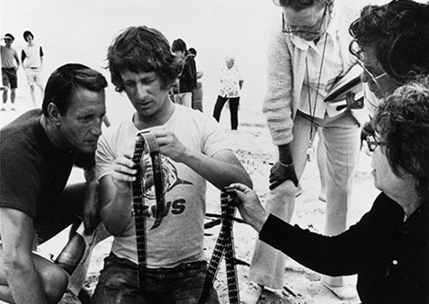 Earlier this summer, HBO announced that Spielberg, a documentary on Steven Spielberg by Susan Lacy, will premiere on the channel October 7th. This week, it was announced that the film will have its world premiere at the New York Film Festival, which runs September 29 through October 15. The documentary includes new interviews with Brian De Palma, Martin Scorsese, Francis Ford Coppola, George Lucas, John Williams, Tom Hanks, Robert Zemeckis, and several others.
Earlier this summer, HBO announced that Spielberg, a documentary on Steven Spielberg by Susan Lacy, will premiere on the channel October 7th. This week, it was announced that the film will have its world premiere at the New York Film Festival, which runs September 29 through October 15. The documentary includes new interviews with Brian De Palma, Martin Scorsese, Francis Ford Coppola, George Lucas, John Williams, Tom Hanks, Robert Zemeckis, and several others.Last month, Deadline's Lisa de Moraes posted some things Lacy said about the doc at a Television Critics Association session:
“He in no way tried to steer this film; he did not see it until it was finished,” Susan Lacy told TV critics of her Steven Spielberg docu for HBO, when asked what the director told her he did and did not want to see in the 2 1/2-hour project.“We did not talk about what I was going to do and wasn’t going to do,” she bristled at Wednesday afternoon’s TCA Q&A on Spielberg, which debuts October 7.
Lacy conducted nearly 30 hours of interviews with Spielberg for the doc.
“I’m a very in-depth interviewer,” she boasted. “We were still deeply in childhood after two hours. He is very shy about interviews; he does very few. [It’s] quite an extraordinary experience to hear him really open up.”
...
“Every actor I interview – and I interviewed everybody – they were most impressed with how much he understands the process of filmmaking and how he sees ahead when he’s shooting,” she said. “Very few filmmakers have that skill. I did so much research.”
Lacy did not, however, interview Spielberg’s wife Kate Capshaw or any of their children for the bio. “She did not want to do an interview for the film; they are very private in terms of their family life,” Lacy explained. “I made the decision not to interview the children,” though she did interview Spielberg’s sister and parents because “they were there at the birth of him becoming a filmmaker.”
Spielberg does not delve into his personal life much, she said, though he does discuss the impact his parents’ divorce had on him and how it informed E.T., for instance.
Lacy also did not dwell on how long it took the the Motion Picture Academy to recognize Spielberg with a Best Picture Oscar. She said she felt the statement about his winning it for the first time with Schindler’s List, after having made six of the top-grossing movies of all time, made the point.
She also did not delve into Spielberg’s involvement with DreamWorks or his work in TV, focusing purely on his directing of movies.
“He is a populist and an artist,” she described. “He’s an incredibly personal filmmaker.”
Lacy added: “For the most commercial filmmaker in history, I do not think box office has ever been what has driven him. What’s driven him is what interests him and what he thinks is important to say.”
The decision to make a 3 1/2-hour black-and-white movie about the Holocaust, she said as a for instance, “did not come out of focus groups. It could have been a huge flop.”
Spielberg explores the directors’ thoughts on Jaws, E.T. The Extra-Terrestrial, Raiders of the Lost Ark, The Color Purple, Schindler’s List, Jurassic Park and Saving Private Ryan. One TV critic at the session noted that the doc does not discuss at any length those of his movies that were not as successful.
“If it isn’t in the film doesn’t mean we did not talk about it,” she countered. “It means I had a 2 1/2 hours.”
Lacy previously helmed PBS’ American Masters for three decades; TV critics wondered what it was like for her to work with HBO’s documentary chief Sheila Nevins. Lacy called it “nothing but pleasure for me.”
“We kiss every morning and hug every night,” joked Nevins.
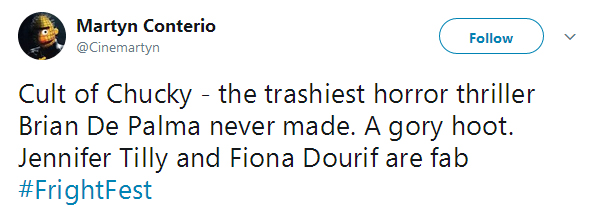
Cult of Chucky is by and large a gory hoot, with Jennifer Tilly stealing every scene she's in. Sprinkled with James Whale-style camp, Brian De Palma's baroque aesthetic and expressionist production design recalling William Cameron Menzies' use of exaggerated sets in Invaders from Mars, Don Mancini's new Chucky film delivers everything a Chucky fan could possibly want: corny one-liners, the carrot-haired monster being horrible to everybody, Jennifer Tilly playing a demented femme fatale and plenty of violence.Since their rejuvenation under the auspice of creator Mancini, the once-controversial Child's Play movies have taken a rewarding tongue-in-cheek approach, with doses of postmodernist winking at the audience. Most slasher movie franchises are on the bones of their arse by the seventh episode, dog-tired and ready for the chop, but with Mancini back on board calling the the shots, Chucky has found a new lease of life, moving away from the dark origins of Child's Play and its two sequels into exclusively horror-comedy territory.
...
Like the best trashy psycho-thriller Brian De Palma never made, Cult of Chucky revels in giddy nonsense. Mancini deploys split-screen, split-focus, suspenseful editing and stages surprisingly icky deaths with aplomb (Nica stomping on a guy's head until its total mush being the chief highlight). And how does a wheelchair user find herself walking? That would be telling. While the plot is supremely silly, hardcore devotees will be delighted to find twists and turns along the way.
FLASHBACK - 2004
Posted June 11 2004 CHUCKY PAYS HOMAGE TO EARLY DE PALMA
CHUCKY PAYS HOMAGE TO EARLY DE PALMA
ACCENTUATED BY DONAGGIO SCORE Don Mancini, who has written all four of the previous films in the Child's Play series, is making his feature directorial debut with the upcoming fifth installment, Seed Of Chucky, which he also wrote. According to Fangoria magazine's January issue (the news of which you can read at Gorezone), Mancini has hired Pino Donaggio to compose the score for the film. "A lot of Seed is a takeoff on Brian De Palma's early movies," Mancini told Fangoria, "and I thought it would be a perfect touch to have his composer do the music for our film as well." Donaggio scored many of De Palma's classic thrillers, beginning with Carrie, and continuing with Dressed To Kill, Blow Out, Body Double, and Raising Cain. He also scored De Palma's comedy, Home Movies, and told an Italian newspaper in 2002 that he would be scoring De Palma's upcoming Toyer. Seed Of Chucky is released in October, and will also feature director John Waters as an "ill-fated papparazzo," according to Mancini.
Don Mancini, who has written all four of the previous films in the Child's Play series, is making his feature directorial debut with the upcoming fifth installment, Seed Of Chucky, which he also wrote. According to Fangoria magazine's January issue (the news of which you can read at Gorezone), Mancini has hired Pino Donaggio to compose the score for the film. "A lot of Seed is a takeoff on Brian De Palma's early movies," Mancini told Fangoria, "and I thought it would be a perfect touch to have his composer do the music for our film as well." Donaggio scored many of De Palma's classic thrillers, beginning with Carrie, and continuing with Dressed To Kill, Blow Out, Body Double, and Raising Cain. He also scored De Palma's comedy, Home Movies, and told an Italian newspaper in 2002 that he would be scoring De Palma's upcoming Toyer. Seed Of Chucky is released in October, and will also feature director John Waters as an "ill-fated papparazzo," according to Mancini.
(Thanks to Space Ace!)
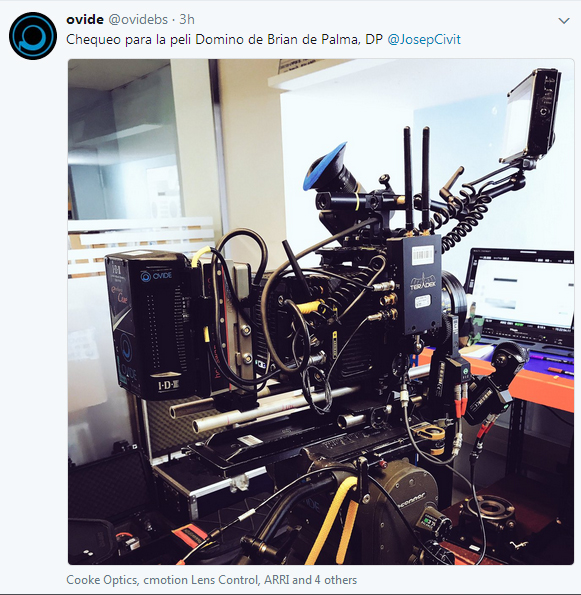
"I wanted to be a movie director. I thought the director was the one who looked at the camera and, when I learned that no, who does it is the director of photography, I already knew what I wanted to be." This is how Josep Maria Civit (Barcelona, 1954) tells us, to whom we find in a single week of summer rest, that Brian De Palma has given to the filming of Domino, between his work in Copenhagen and what he will do in the coming weeks in Almería. It is not the only film in which one of the Catalan directors of photography is now working with a more solid and expanded career. In early summer, we see in the photo, Civit was in London, under the orders of Agustí Villaronga, in a part of the filming of the next filmmaker of the Mallorcan filmmaker, Born a King, a Spanish, English and Spanish co-production Saudi Arabia, where they will shoot in October to avoid high current temperatures. "I do not stop this summer," Civit says: "The truth is that my summers always have me busy." In any case, he is satisfied. "I spent the summer between two privileged minds: that of Agustí Villaronga and that of Brian De Palma. I'm delighted. We move from one place to another, but to me, regarding work, what interests me is that I make a trip to the director's head in every movie. It is he who has the skin on his head."
 Tomorrow (August 22nd), Intrada is releasing a newly remastered edition of its Body Double soundtrack, which the label originally issued in 2008. "Popular, wildly flamboyant Pino Donaggio horror soundtrack gets facelift!" begins the description on the Intrada website. About this new edition, the site states that the "new 2017 edition of Body Double is presented from all new master incorporating several important sonic advantages including much-improved levels, stereo balancing of many tracks, courtesy pristine source elements from Columbia Pictures." As an added bonus track, they have added "original trailer music by Jonathan Elias, with its lush, romantic John Barry-ish vibe, also presented in stereo."
Tomorrow (August 22nd), Intrada is releasing a newly remastered edition of its Body Double soundtrack, which the label originally issued in 2008. "Popular, wildly flamboyant Pino Donaggio horror soundtrack gets facelift!" begins the description on the Intrada website. About this new edition, the site states that the "new 2017 edition of Body Double is presented from all new master incorporating several important sonic advantages including much-improved levels, stereo balancing of many tracks, courtesy pristine source elements from Columbia Pictures." As an added bonus track, they have added "original trailer music by Jonathan Elias, with its lush, romantic John Barry-ish vibe, also presented in stereo."Popular, wildly flamboyant Pino Donaggio horror soundtrack gets facelift! Columbia Pictures presents, Brian De Palma directs, Craig Wasson, Melanie Griffith, Gregg Henry - and a really big drill star. De Palma pays homage to Hitchcock with this fascinating tale of murder and obsession. Donaggio, frequent collaborator with De Palma, provides vivid, full-blooded score with balance of French horn-led power, string-led romance, quasi-soft rock beat to cover all the bases of this over-the-top thriller. Donaggio offers haunting, achingly beautiful theme for piano, strings over the titles to anchor, but interestingly precedes it with intentionally cheesy faux-horror vampire music for on-screen low budget film in production. With two ideas established, Donaggio then takes listener on multi-path listening experience: source music with rhythm at core, dramatic suspense material, powerful fortissimo horror sequences, rousing chase music, gentle melancholy, you name it. Donaggio excels with the horror genre, especially for De Palma. Dressed To Kill, Blow Out, Carrie are other favorites of the genre and Donaggio brings each a blend of haunting beauty and terrifying thrills. Body Double is arguably the most involved in terms of scoring, offering the widest range of material and the most florid in execution. The highlights are numerous: sensual major-key melody of “The Telescope” with its sexy female voice mingling amongst the orchestral colors, varied action and orchestral drama of “Rendezvous; Purse Grab; Tunnel Claustrophobia”, lengthy and incredible unison French horn power of “The Big Drill” underscoring hair-raising murder scene, hypnotic repeating phrases of “Detective McClane, Please!”, pulsating action of “A Night On Mulholland Drive; A Grave For Holly”, “Terror In The Grave”, many others. Orchestrational tidbit: Donaggio scores for full symphony but tacets trumpets. Resulting brass sound imbues score with darker, intenser quality. Originally premiered by Intrada in 2008, new 2017 edition of Body Double is presented from all new master incorporating several important sonic advantages including much-improved levels, stereo balancing of many tracks, courtesy pristine source elements from Columbia Pictures. New edition also premieres original trailer music by Jonathan Elias, with its lush, romantic John Barry-ish vibe, also presented in stereo. Otherwise, selections and packaging remain similar. Crisply recorded at The Burbank Studios across two weeks in September 1984. Pino Donaggio composes, Natale Massara conducts. Intrada Special Collection CD available while quantities and interest remain!
Larry King: Cory Anderson on the Larry King Now blog asks, “What can you tell us about your new film Domino?"Nikolaj: Oh, yes, that’s a European movie that Brian De Palma is directing. We’re shooting it right now.
Larry King: Really?
Nikolaj: Yeah, it’s really cool. I’m very lucky I get to work with him. He’s brilliant, he’s…
Larry King: [motioning] He lays everything out, right?
Nikolaj: Yeah. And then [hands tunneling from his eyes] he has this very specific vision. It’s a thrilling story. It’s about what goes on in Europe now, with the paranoia… it’s a thriller, and it’s about this constant sense of threat from terrorist attacks.
Larry King: You’re shooting now?
Nikolaj: We’re shooting now, yeah.
Larry King: Where?
Nikolaj: We’re shooting in Denmark, in Brussels, and Spain.
Larry King: You like all the traveling?
Nikolaj: I do, yeah.
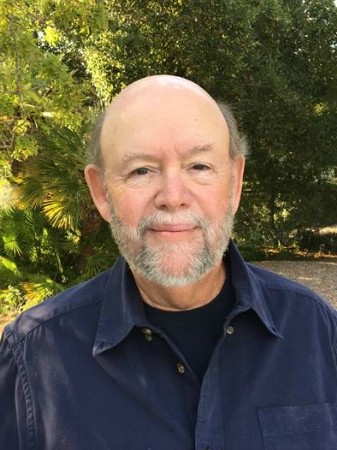 Paul Hirsch, who has collaborated on eleven films with Brian De Palma, will be honored at Poland's 25th annual Camerimage festival this November. Hirsch will be presented with the Camerimage Award To Editor With Unique Visual Sensitivity. Camerimage runs November 11-18 in Bydgoszcz.
Paul Hirsch, who has collaborated on eleven films with Brian De Palma, will be honored at Poland's 25th annual Camerimage festival this November. Hirsch will be presented with the Camerimage Award To Editor With Unique Visual Sensitivity. Camerimage runs November 11-18 in Bydgoszcz.Let us start with a riddle. What is the connection between a blood-soaked Sissy Spacek unleashing a school massacre, the Rebel Alliance pilots desperately attacking the Death Star, Kevin Bacon dancing vigorously to his own beat, Matthew Broderick clowning around in Chicago, Michael Douglas going berserk with guns on Los Angeles streets, Tom Cruise hanging down on a line from a ceiling or Burj Khalifa sky-scraper, and Jamie Foxx working wonders on a piano? The obvious remark is, of course, the inexpressible magic of cinema, but there is also a less abstract answer: the connection is the editor. A man who made sure the abovementioned moments from Carrie, Star Wars: Episode IV - A New Hope, Footloose, Ferris Bueller’s Day Off, Falling Down, Mission: Impossible, Mission: Impossible - Ghost Protocol, and Ray were not only a series of moving pictures but also absorbing, internally coherent sequences that arose from what happened earlier in the given film and foreshadowed what would follow next.Paul Hirsch, as he was the editor of all of these films, has been working in the film industry for half a century, and collaborated with such filmmakers as Brian De Palma, George Lucas, Irvin Kershner, Herbert Ross, John Hughes, Joel Schumacher, Taylor Hackford, and Duncan Jones. In the past, he worked with Moviola and other tools available for editors, creating the given picture’s rhythm, mood and audiovisual character by physically cutting and pasting bits of film; now he works with the latest editions of expensive computer software but his style and editor’s creed did not change a bit. What is important is the story and the characters that make it what it is and move forward, irrespective of the film’s genre; the same applies to the low-budget shocking 70s thriller Sisters and recent Hollywood’s fantasy spectacle Warcraft about a war between the orcs and the humans.
During his distinguished career Paul Hirsch was honored with numerous awards and accolades, including an Academy Award® for Star Wars: Episode IV - A New Hope (shared with Marcia Lucas and Richard Chew). We are therefore proud to announce that in a couple of months Paul Hirsch will personally come to Bydgoszcz to accept Camerimage Award to Editor with Unique Visual Sensitivity.
Hirsch’s mentor and the filmmaker who shaped him as an editor and helped in perfecting his skills was Brian De Palma. Starting with 1970's Hi, Mom! they have so far made together eleven feature films, the last being 2000's Mission to Mars. Their projects are often considered masterworks of the art of editing. Like in 1981’s Blow Out, a tale about a sound engineer who is accidently implicated in a politically-motivated murder, in which Hirsch and De Palma created, in parallel with a standard narrative, an amalgam of images and sounds that establishes new ways of interpretation and significantly alters how the story is perceived. Another brilliant example of their work is 1996’s Mission: Impossible, a classic spy thriller made and told in ways of then-modern action films – as in the thrilling and suspenseful sequence of a bold break into the CIA headquarters, or the breathtaking sequence with a helicopter, a train and a narrow tunnel. Hirsch stated in one of his interviews: “Brian taught me a lot about the difference between cutting trailers and cutting features. And my two other great teachers were trial and error.”
Before Paul Hirsch started working as a feature film editor, he had to go through a number of different jobs and learn different ways of his craft. He began his career quite modestly, in a New York-based shipping room. There, he met a negative cutter who took him under his wings as a trainee and taught how to use Moviola, among many other things. This new set of skills opened Hirsch many possibilities, and made it possible to start working for film trailer editor Chuck Workman. He gave Hirsch a task of cutting down a featurette about the making of Norman Jewison’s The Thomas Crown Affair, and afterwards let him do on his own the same type of material for Ken Hughes’s Chitty Chitty Bang Bang. Then, Hirsch moved onto editing trailers for films like Peter Medak’s Negatives and Brian De Palma’s Greetings, the latter being produced by his brother, Chuck Hirsch.
This was the real beginning of Hirsch and De Palma’s successful, decades-long collaboration that resulted in countless moments of cinematic joy for viewers around the world. And because De Palma was friends with Scorsese, Spielberg, Lucas and other rebels of the New Hollywood, soon Hirsch has found himself working on much bigger projects. One of them, the most famous space opera in the history of cinema, made him legendary; he started working on Star Wars as one of three editors, but finished the work on his own. Among the many scenes he was personally responsible for, we can find the annihilation of Alderaan, the famous Mos Eisley cantina duel, the fight for life and death between Obi-Wan Kenobi and Darth Vader, as well as most of the sequence of the daredevil attack on the Death Star. Academy Award® for Star Wars changed not only Hirsch’s personal and professional life, but also altered the way of thinking of the American film industry that fell in love with this style of editing, elevated soon by Hirsch himself when he worked for George Lucas and Irvin Kershner on the sequel, The Empire Strikes Back.
Paul Hirsch always stayed true to his editing creed of adjusting the rhythm and the sense of time and space to the film’s story and the characters’ personalities and emotional arcs. He also made his work invisible to the viewer’s eye, just as any editor should. That is precisely why, after the success of A New Hope, he did not want to lose himself in cutting the latest Hollywood blockbusters. Instead he looked for interesting challenges. He found them aplenty in films such as Herbert Ross’s popular musical Footloose, John Hughes’s buddy comedy Planes, Trains & Automobiles, and Joel Schumacher’s urban thriller Falling Down in which he assisted the director and actor Michael Douglas in infusing the story with the kind of raw energy that made the protagonist’s anger and internal struggle even more palpable. But then Hirsch also used his skills in many other genres, including Steve Miner’s horror-comedy Lake Placid, or Herbert Ross’s comedy-drama Steel Magnolias. He reached another milestone of his career with Taylor Hackford’s Ray, in which the way and the rhythm of cutting were made accordingly with the personality and musical style of Ray Charles. For his work on that film he earned another Academy Award® nomination.
During the last couple of years Paul Hirsch [has] worked mostly on big-budget Hollywood spectacles, but the American editor did not forget the essentials of his job: character motivation and drama, and storytelling that will make the audiences sitting in a dark screening room forget about the problems of everyday life. We are excited that Paul Hirsch will soon visit Bydgoszcz for the 25th anniversary of the International Film Festival of the Art of Cinematography CAMERIMAGE. By accepting our Award to Editor with Unique Visual Sensitivity he will join the ranks of such eminent editors as Walter Murch, Martin Walsh, Joel Cox, Alan Heim, Chris Lebenzon, Thelma Schoonmaker, and Pietro Scalia. Additionally, Paul Hirsch will meet the festival’s participants during a Q&A session after the screening of his film, to which event we already sincerely invite everyone attending Camerimage.
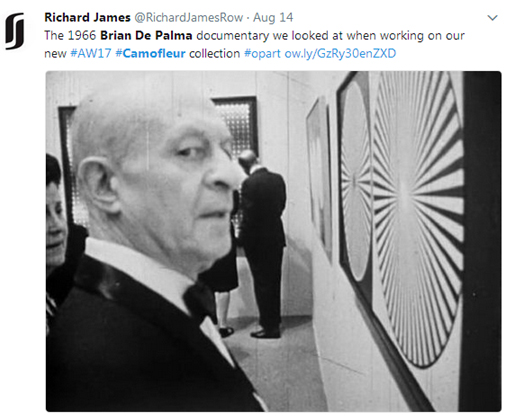
As a young filmmaker, long before the delights of Dressed to Kill, Scarface and, more recently, Mission Impossible, Brian De Palma made documentaries.One, notably, was The Responsive Eye, which looked at the groundbreaking exhibition of the same name that was held at The Museum of Modern Art in 1965.
De Palma’s film was something we looked at quite closely when we were putting together our new AW17 Camofleur collection, which takes inspiration from the work of the celebrated razzle dazzle camofleur Norman Wilkinson and the Op Art movement of the sixties and early seventies that his engagingly geometric work went on to influence.
According to the author and curator Marina Weinhart, The Responsive Eye exhibition – which featured 123 works by such artists as Victor Vasarely, Bridget Riley and Josef Albers – represented “the height of the Op Art wave”.
And by way of defining Op Art, the exhibition’s curator William C Seitz said of it at the time: “These works exist less as objects to be examined than as generators of perceptual responses, of colors and relationships existing solely in vision. They exert a control over perception capable of arousing delight, anxiety and even vertigo.”
Designed to induce delight more than anxiety and vertigo, you can see a strong Op Art influence and something of Norman Wilkinson’s razzle dazzle camouflage in certain of our new-season shirts, ties, pocket squares and scarves.